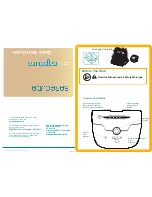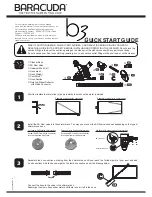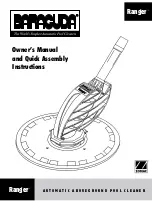
owner's manual when installing and operating equipment.
Have a trained pool professional perform all pressure
tests.
1. Do not connect system to a high pressure or city water
system.
2. Use equipment only in a pool installation.
3. Trapped air in system can cause explosion. BE SURE all
air is out of system before operating or testing equipment.
Tighten Sta-Rite trap lids to hand tight only.
Water pressure must be less than 25 PSI (7.5 kg/cm
2
).
Water Temperature must be less than 104
o
F (40
o
C).
Fire and burn hazard.
Modern motors run
at high temperatures. To reduce the risk of fire, do not
allow leaves, debris, or foreign matter to collect around
the pump motor. To avoid burns when handling the
motor, let it cool for 20 minutes before trying to work on
it. An automatic internal cutoff switch protects the motor
from heat damage during operation.
INSTALLATION
For ease of pump/motor removal, install pipe unions on
the suction and discharge pipes close to pump.
Pump mount must:
Be located away from corrosive or flammable liquids.
Have enough ventilation to maintain air temperature at less
than the maximum ambient temperature rating (Max. Amb.)
listed on the motor model plate. If this pump is installed in an
enclosure/pump house, the enclosure must have adequate
ventilation and air circulation to keep the temperature in the
enclosure at or below the motor’s rated ambient temperature
whenever the pump is running.
Be solid - Level - Rigid - Vibration free. (To reduce vibra-
tion and pipe stress, bolt pump to mount.)
Allow pump suction inlet height to be at or below water
level in pool.
Allow use of short, direct suction pipe (To reduce friction
losses).
Allow for gate valves in suction and discharge piping.
Have adequate floor drainage to prevent flooding.
Be protected from flooding.
Allow adequate access for servicing pump and piping.
NOTICE:
Use Teflon tape or Plasto-Joint Stik
1
for making
all threaded connections to the pump. Do not use pipe
dope; pipe dope will cause stress cracking in the pump.
NOTICE:
Pump suction and discharge connections have
molded in thread stops. DO NOT try to screw pipe in
beyond these stops. Tighten the pump/trap fittings only
as much as it is required to insure a tight connection (1-
1/2 turns past hand tight is sufficient). Overtightening may
damage the pump trap. Use care when using teflon tape
as friction is reduced considerably; do not overtighten
connections or damage may occur.
Teflon Taping Instructions:
Use only new or clean PVC pipe fittings.
Wrap male pipe threads with one to two layers of Teflon
tape. Cover entire threaded portion of pipe.
Do not
overtighten or tighten past thread stop in pump
port!
If leaks occur, remove pipe, clean off old tape, rewrap
with one to two additional layers of tape and remake the
connection.
NOTICE: Support all piping connected with pump!
Piping:
To avoid strains on the pump, support both suction and
discharge pipes or hoses independently. Place these
supports near the pump.
To avoid airlocking, slope suction pipe slightly upward
toward the pump.
NOTICE:
To prevent flooding when removing pump for
service, all flooded suction systems
must
have gate
valves in suction and discharge pipes.
Union available for pump discharge port (Sta-Rite part
number WC198-105). Use as follows for leak-free con-
nection to pump:
1. O-Ring and sealing surfaces must be clean.
2. Assemble handtight only! (NO WRENCHES!)
3. NO pipe compound or teflon tape on union.
4. Bond pipe to union with PVC cement.
Use PVC cement only in a well ventilated
area away from flame; FOLLOW MANUFACTUR
ER’S INSTRUCTIONS!
Fittings:
Fittings restrict flow; for best efficiency use fewest possi-
ble fittings.
Avoid fittings which could cause an air trap.
1
Lake Chemical Co., Chicago, Illinois
DO N
OT
OVE
R TIG
HTE
N
Strainer
Basket
Cover
1
1
/
2
" NPT
Suction Port
Drain
Plug
1
1
/
2
" NPT
Discharge
Port
FIGURE 1
3
Содержание ABG Series
Страница 12: ...12 BLANK PAGE ...
Страница 24: ...NOTES S486 Rev A 02 07 2007 ...



































